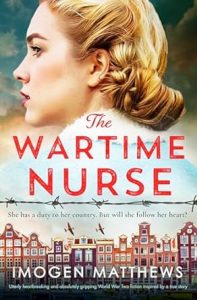Forgotten Stories as a Rich Source for Historical Fiction
By Imogen Matthews
 Readers of my historical fiction books will know that I have a passion for discovering stories about the Dutch who lived under brutal German occupation during World War 2. Over the past decade I have uncovered stories about a woodland hideout for Jews, the astonishing bravery of young boy who bravely smuggled letters into a Dutch concentration camp and the remarkable account of three young women (two were sisters) who became key members of Dutch resistance. I’m exploring two more for forthcoming novels.
Readers of my historical fiction books will know that I have a passion for discovering stories about the Dutch who lived under brutal German occupation during World War 2. Over the past decade I have uncovered stories about a woodland hideout for Jews, the astonishing bravery of young boy who bravely smuggled letters into a Dutch concentration camp and the remarkable account of three young women (two were sisters) who became key members of Dutch resistance. I’m exploring two more for forthcoming novels.
My latest, The Wartime Nurse, is the third book in The Dutch Girl Series, and follows the story of Freddie Oversteegen, who was just fourteen when war broke out. Like her sister, Truus, and their friend Hannie Schaft, the three women banded together to take terrifying action against the Nazis and their collaborators. Women in wartime were expected to keep the home fires burning and let the men get on with the fighting. However, these relatively unknown women were prepared to give their lives for what they believed in, the right to defend their country from the enemy.
My interest in stories set in wartime Holland came from my Dutch background and listening to my Dutch mother’s stories when growing up. She was nineteen and excited by the prospect of going to University in Leiden when war broke out. Four years later, the Universities had been closed by the German authorities who were still very much in control. The Dutch population was on the point of starvation as the weather turned bitterly cold. It was only through my mother’s resourcefulness and grit that she was able to feed her family by boiling tulip bulbs that she’d dug up from the frozen soil.
It wasn’t until years later that I had thoughts of becoming a historical fiction writer. It happened the day I stumbled across an underground hut hidden deep in the Veluwe woods in a beautiful area of the Netherlands. By the side of the cycle path I was on was a large granite stone with an inscription in Dutch to the local community who had sacrificed so much to help fugitives during World War 2. Close by was an information board with illustrations of a woodland village that had been created in 1943 to protect people who were on the run from the Nazis. I’d never heard about this place despite many years cycling through these woods.
Intrigued, I walked deep into the woods in search of the underground huts. They were so well hidden, that I could only imagine what it must have been like for these people, forced to keep quiet all day and forbidden to light fires, because smoke would have alerted the patrolling Germans to this woodland village of some eighty people.
Eventually my eyes focused on a slight indentation in the soil amongst the trees. It was covered with moss and pine branches. To one side was a low wooden door and I entered into a dark cramped dwelling. It took a moment or two to register bunk beds hewn from tree trunks and a central round wooden table and stools. It was hard to imagine what kind of a life the people who lived here must have had. How could so many people have survived here for so long without being detected by the Germans who were known to roam these woods in search of Jews?
The very idea of it made my spine tingle and set my imagination on fire. It was a story that few people had heard about but needed to be told. I wanted to be the person to tell that story.
The next step was research, but I found very little had been written about the place, until I discovered a book called Het Verscholen Dorp (the hidden village) written in Dutch on a second-hand website. Together with my mother’s stories about her life during the war, I felt qualified to start writing.
After The Hidden Village had been published on Amazon and my publisher had persuaded me to write a sequel called Hidden in the Shadows, I thought about what to write next. A friend asked if I knew about Kamp Amersfoort, a Nazi-run concentration camp where 37,000 people, mainly Jews and dissidents, were imprisoned between 1941 and 1945. My friend told me that not many people knew about it and I should go and find out for myself.
While I was as the visitor centre shop at Kamp Amersfoort I bought a book about a local farmer and his son who were granted access by the German authorities to go into the camp daily to collect potato peelings for their cattle. I was captivated by this story, just as I had been the first time I visited the real hidden village, and the idea for a novel seeded itself in my mind. A novel that would hopefully give insight into a concentration camp that few people knew about yet was every bit as important as the German camps that have been extensively written about. That novel became The Girl Across the Wire Fence, based on the true story of ordinary people who risked their lives help prisoners at one Holland’s largest, yet least known, concentration camps.
Compelling stories such as these deserve to be better known, no more so than at the present time with so much conflict across the world. I believe we should always remember that the stories of the past can teach us much about ourselves and the lives of other people.
—
Imogen Matthews is an Oxford-based, award-winning author and journalist with an interest in forgotten stories from WW2 Holland. Imogen was born in Rijswijk, Holland, to a Dutch mother and English father who moved the family to England when Imogen was very young. All her life, she listened to her mother’s stories about her life in Holland, in particular the hardships she faced during the Hunger Winter in 1944-5, which has had a profound impact on her writing.
—
 An ear-splitting blast blows me sideways and debris starts to fall on top of me. In my shock it takes me a moment to realise the very worst has happened – the hospital has been bombed. The screams of panicked patients are deafening. But I can only think about one thing – my darling Will. Where is he?
An ear-splitting blast blows me sideways and debris starts to fall on top of me. In my shock it takes me a moment to realise the very worst has happened – the hospital has been bombed. The screams of panicked patients are deafening. But I can only think about one thing – my darling Will. Where is he?
1944, Nazi-occupied Holland. As Nurse Freddie cycles through the tulip fields, she looks like any other law-abiding citizen. But beneath her innocent smile lies an iron will to fight for freedom. The Nazis have no idea she is part of the resistance, and that she risks her life every day to deliver food and messages to hidden refugees.
After a failed attempt to take the life of a Nazi collaborator, Freddie is sent to an underground hospital to tend to a group of injured Allied airmen. And when unconscious English pilot Will wakes up and locks his dazzling blue eyes with hers, her heart jolts. As she tends to his wounds, she can’t help but fall deeply in love with this charming English officer.
Will and Freddie start to dream about a future after the war, but when the hospital is bombed by the Nazis, they lose each other in the chaos. With her heart shattered, Freddie vows to find Will and get him to safety – even if that means letting him go forever.
But Freddie’s world comes crashing down when she learns that Will has been captured. To save him, Freddie must infiltrate the hospital where he is held captive. But will saving him cost Freddie her life or her heart?
Inspired by the incredible true story of a brave young woman who would stop at nothing to fight for her country, The Wartime Nurse is an utterly heart-wrenching and emotional World War Two novel of one woman’s courage and the power of true love. Perfect for fans of Heather Morris, Kristin Hannah and Fiona Valpy.
BUY HERE
Category: How To and Tips






























